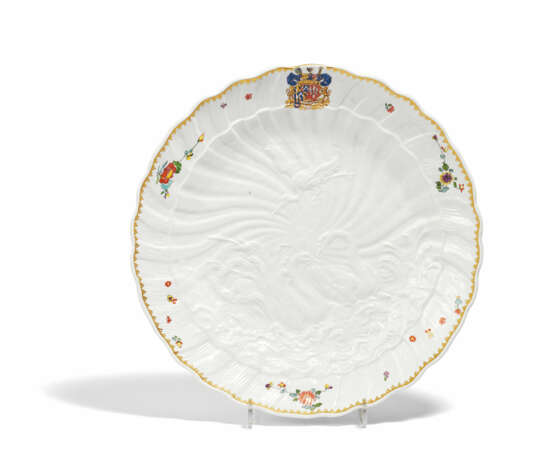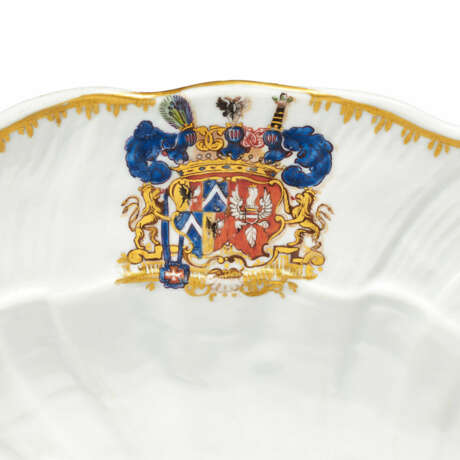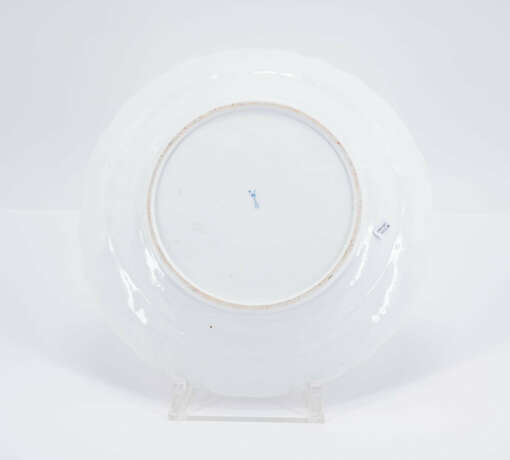ID 953401
Lot 1054 | Round bowl from the swan service of Count Brühl
Valeur estimée
€ 9 000 – 11 000
Meissen.
Date: Molding around 1738-1739.
Maker/Designer: Model J.J. Kaendler, 1738.
Technique: Porcelain, decorated with colors and gold.
Description: Slightly curved rim with scallop ribs and wavy edge contour. In the center, in front of
scallop-like structures, a relief of two swans facing each other, swimming on the waves of
a reed-lined pond. In the reeds, to their left stands a heron with carp in its beak, a
second heron flying over them. Along the edge of the rim a stylized trefoil frieze in
gold. On the rim, above the flying heron, the large alliance coat of arms
Brühl-Kolowrat-Krakowský flanked by lions, as well as three bouquets with Indian flowers
and small scattered blossoms.
Measurement: Height 4,8cm, Ø 30cm.
Mark: Swordsmark, former's sign presumably of Johann Elias Grund.
Provenance:
Private collection Hamburg, acquired from Kunsthandel Steinbeck, Aachen.
Literature:
Exhibit-Cat.: Schwanenservice - Meissener Porzellan für Heinrich Graf von Brühl, ed.: Ulrich Pietsch, Dresden 2000.
For the model of the present bowl see p.158, cat.-no.27.
In May 1736, Johann Joachim Kaendler noted in his daily reports that his Exellency the Cabinet Minister Brühl had commissioned a dinner service that was to be designed in a completely new manner. This first reference to the swan service already makes it clear that Brühl was not satisfied with the already existing repertoire of shapes of the Meissen manufactory, but that the enormous effort to produce new molds had to be taken on. In order to be able to meet Brühl's demanding requests, Kaendler invested a great deal of effort in the conception of the designs. He produced 46 different sample plates, which were presented to Brühl for selection between July 1737 and January 1738.
Brühl, who as an art-conscious client and patron, acknowledged innovative ideas as such. He finally chose a sample plate with an elaborate relief decor, which represented a spectacular innovation in the decorative design of European dinner services. The motif on the sample plate with the scallop and swan relief, became the starting point for the leitmotif of the entire ensemble: the flora and fauna of water and the world of mythological figures associated with it.
When Kaendler modeled the first plate with the swan relief, he described it in his work report as follows: "[...] a plate, which was in the shape of a sea shell, 2 swimming swans together with two other water birds and reeds cut flat into it". A chalcography based on a drawing by the English artist Francis Barlow (1626-1702) probably served him as a model for the relief. Two sheets with the motif are still to be found in the graphic collection of the Staatliche Kunstsammlungen Dresden.
The shape of the plate was sculpted following a model from nature: the rim with wavy edge shows a relief of fan-shaped ribs, which is an imitation of the texture on the back of a scallop shell. The shallow serving bowls were designed in the same manner as the plates with the swan relief. They were modeled in five different sizes, with their rims becoming narrower as the size increased. For each size there was the matching cloche with gilded bronze handle.
| Fabricant: | Usine de porcelaine Meissen |
|---|---|
| Catégorie maison de vente aux enchères: | Porcelaine |
| Fabricant: | Usine de porcelaine Meissen |
|---|---|
| Catégorie maison de vente aux enchères: | Porcelaine |
| Adresse de l'enchère |
VAN HAM Kunstauktionen GmbH Hitzelerstr. 2 50968 Köln Allemagne | ||||||||||||||
|---|---|---|---|---|---|---|---|---|---|---|---|---|---|---|---|
| Aperçu |
| ||||||||||||||
| Téléphone | +49 221 92586215 | ||||||||||||||
| Fax | +49 221 92 58 62 4 | ||||||||||||||
| Commission | 32% | ||||||||||||||
| Conditions d'utilisation | Conditions d'utilisation | ||||||||||||||
| Heures d'ouverture | Heures d'ouverture
|





